Prompt: Dupe arts
Mixed media、Video
118x78cm、6’39”
2024
Prompt: Dupe arts
複合媒材、錄像
118x78cm、6’39”
2024
Collaborator : Shanboy CHEN
![]()
![]()
《Prompt: Dupe arts》,未來媒體藝術節,臺灣當代文化實驗場提供,攝影:三月影像 許博彥
The term "Dupe" in Dupe Arts reflects the rise of Dupe Culture that has emerged alongside the booming development of social media and e-commerce platforms in China, with a significant following in the West as well. This culture revolves around the pursuit of lower-priced alternatives that resemble high-end products in quality and style, promoting rational consumption and creativity. It is more than just a trend; it's a lifestyle choice that values resourcefulness over luxury. Unlike counterfeits, dupes do not mimic original trademarks but offer legal alternatives with similar design and functionality, which can even increase consumer desire for the original products by expanding their visibility.
Following this philosophy, Dupe Arts is not about copying or mechanical reproduction, like a replica painting, but rather imitation of existing artworks, capturing their essence in a more accessible form. The psychological motivation behind Dupe Arts is both a critique of high art and an aspiration towards it, suggesting potential for broader dissemination. Similarly, image-generating AI operates on a parallel logic by producing visually compelling works at a lower cost through complex imitation and recombination of existing images. In this context, exploring prompts and datasets becomes a new avenue for creativity.
For many, the demand for art may not hinge on originality. However, for creators, originality remains a crucial marker of artistic agency. How does the art market assign value? What impact will AI-generated art have as a dupe tool? How should creators respond?
We searched "Dupe Arts" on Youtube and saw that Youtubers were teaching a simple and affordable way to draw abstract paintings that looked like those in expensive galleries. We draw according to the steps, and then take photos of the finished works and feed them to the generative AI, which generates a large number of similar abstract paintings.
Dupe Arts 中的 Dupe 指的是近幾年隨中國的自媒體、電商平台蓬勃發展所興起的「平替文化」(平價替代品),在歐美亦蔚為風潮。指尋找價格較低但品質和款式跟高價產品相似的替代品的消費現象,並認為尋找的過程可以激發創意和探索。平替文化不僅是省錢的消費現象,更是一種理性消費的生活態度體現。平替品並非仿冒原商品,而是一種相對合法的替代方案,亦可以提升消費者對原商品的嚮往。
承襲於此,Dupe Arts 並非抄襲,也不是如複製畫的機械複製,而更像是對於現成物的「模仿」,透過平價的方式創作出風格接近的作品。Dupe Arts 的心理動機既是對高貴藝術品的反動,同時也是嚮往,更是一種擴散的可能。圖像生成AI 也存在類似邏輯,以低廉的成本對資料集中的現成圖像,進行「複雜的模仿與重組」。為了生成出更滿意的圖像,對於提示詞與資料集的現成圖像的探索,亦成為一種新的創意可能。
從 Dupe Arts 或是圖像生成 AI 來看,對也許為數不少的人來說,他們對藝術的「需求」並不是原創性,然而對身為藝術「供給」者的創作者來說,原創性又是創作者的「能動性」的重要證據。藝術是如何被賦予價值?圖像生成 AI 作為一種平替工具又會產生什麼影響?身為創作者的我們又該如何面對?
我們在Youtube搜尋「Dupe Arts」,看到Youtuber在教學以簡單又平價的方式,畫出如同昂貴畫廊的抽象繪畫作品。我們照著步驟畫出,再將畫好後的作品翻拍成照片給生成式AI,生成出大量相似的抽象繪畫作品。
![]()
![]()
![]()
![]()
《Prompt: Dupe arts》錄像截圖,照著Youtuber的Dupe arts教學畫出抽象作品
![]()
《Prompt: Dupe arts》錄像截圖,用Stable Diffusion生成出大量類似的抽象圖樣
![]()
《Prompt: Dupe arts》,未來媒體藝術節,臺灣當代文化實驗場提供,攝影:三月影像 許博彥
Open Source Software Used:
stable-diffusion-webui AGPL-3.0 license
ControllNet Apache-2.0 license
stable-diffusion-v1-5/stable-diffusion-v1-5 CreativeML Open RAIL-M
Youtube Video Source:
Dupe for $4,300 Artwork! + Home Decor Updates! RAVEN ELYSE DIY
Gaffer:
Itami Liang
燈光指導:
梁敦學
Mixed media、Video
118x78cm、6’39”
2024
Prompt: Dupe arts
複合媒材、錄像
118x78cm、6’39”
2024
Collaborator : Shanboy CHEN
共同創作者:陳宣伯


《Prompt: Dupe arts》,未來媒體藝術節,臺灣當代文化實驗場提供,攝影:三月影像 許博彥
The term "Dupe" in Dupe Arts reflects the rise of Dupe Culture that has emerged alongside the booming development of social media and e-commerce platforms in China, with a significant following in the West as well. This culture revolves around the pursuit of lower-priced alternatives that resemble high-end products in quality and style, promoting rational consumption and creativity. It is more than just a trend; it's a lifestyle choice that values resourcefulness over luxury. Unlike counterfeits, dupes do not mimic original trademarks but offer legal alternatives with similar design and functionality, which can even increase consumer desire for the original products by expanding their visibility.
Following this philosophy, Dupe Arts is not about copying or mechanical reproduction, like a replica painting, but rather imitation of existing artworks, capturing their essence in a more accessible form. The psychological motivation behind Dupe Arts is both a critique of high art and an aspiration towards it, suggesting potential for broader dissemination. Similarly, image-generating AI operates on a parallel logic by producing visually compelling works at a lower cost through complex imitation and recombination of existing images. In this context, exploring prompts and datasets becomes a new avenue for creativity.
For many, the demand for art may not hinge on originality. However, for creators, originality remains a crucial marker of artistic agency. How does the art market assign value? What impact will AI-generated art have as a dupe tool? How should creators respond?
We searched "Dupe Arts" on Youtube and saw that Youtubers were teaching a simple and affordable way to draw abstract paintings that looked like those in expensive galleries. We draw according to the steps, and then take photos of the finished works and feed them to the generative AI, which generates a large number of similar abstract paintings.
Dupe Arts 中的 Dupe 指的是近幾年隨中國的自媒體、電商平台蓬勃發展所興起的「平替文化」(平價替代品),在歐美亦蔚為風潮。指尋找價格較低但品質和款式跟高價產品相似的替代品的消費現象,並認為尋找的過程可以激發創意和探索。平替文化不僅是省錢的消費現象,更是一種理性消費的生活態度體現。平替品並非仿冒原商品,而是一種相對合法的替代方案,亦可以提升消費者對原商品的嚮往。
承襲於此,Dupe Arts 並非抄襲,也不是如複製畫的機械複製,而更像是對於現成物的「模仿」,透過平價的方式創作出風格接近的作品。Dupe Arts 的心理動機既是對高貴藝術品的反動,同時也是嚮往,更是一種擴散的可能。圖像生成AI 也存在類似邏輯,以低廉的成本對資料集中的現成圖像,進行「複雜的模仿與重組」。為了生成出更滿意的圖像,對於提示詞與資料集的現成圖像的探索,亦成為一種新的創意可能。
從 Dupe Arts 或是圖像生成 AI 來看,對也許為數不少的人來說,他們對藝術的「需求」並不是原創性,然而對身為藝術「供給」者的創作者來說,原創性又是創作者的「能動性」的重要證據。藝術是如何被賦予價值?圖像生成 AI 作為一種平替工具又會產生什麼影響?身為創作者的我們又該如何面對?
我們在Youtube搜尋「Dupe Arts」,看到Youtuber在教學以簡單又平價的方式,畫出如同昂貴畫廊的抽象繪畫作品。我們照著步驟畫出,再將畫好後的作品翻拍成照片給生成式AI,生成出大量相似的抽象繪畫作品。




《Prompt: Dupe arts》錄像截圖,照著Youtuber的Dupe arts教學畫出抽象作品

《Prompt: Dupe arts》錄像截圖,用Stable Diffusion生成出大量類似的抽象圖樣

《Prompt: Dupe arts》,未來媒體藝術節,臺灣當代文化實驗場提供,攝影:三月影像 許博彥
Open Source Software Used:
stable-diffusion-webui AGPL-3.0 license
ControllNet Apache-2.0 license
stable-diffusion-v1-5/stable-diffusion-v1-5 CreativeML Open RAIL-M
Youtube Video Source:
Dupe for $4,300 Artwork! + Home Decor Updates! RAVEN ELYSE DIY
Gaffer:
Itami Liang
燈光指導:
梁敦學
Observatory melting on the roof
2024
在屋頂融化的天文台
單頻道錄像
5’11”
2024
Even if I could have an observatory on the rooftop of my own home, it would feel like I’m only a little closer to astronomy. The vast scale of the distant universe makes my tiny self feel as powerless as a melting observatory.
即便能在自家屋頂擁有天文台,好像也只是靠近天文那麼一點點,遙遠的宇宙尺度之大,渺小的自己就像是融化的天文台般無能為力。
Single-channel video
5’11”2024
在屋頂融化的天文台
單頻道錄像
5’11”
2024
Even if I could have an observatory on the rooftop of my own home, it would feel like I’m only a little closer to astronomy. The vast scale of the distant universe makes my tiny self feel as powerless as a melting observatory.
即便能在自家屋頂擁有天文台,好像也只是靠近天文那麼一點點,遙遠的宇宙尺度之大,渺小的自己就像是融化的天文台般無能為力。
From Hsinchu Science Park's Moon
Diffuser plates, LED
Dimension variable
2024
來自竹科的月光
擴散板、LED燈
依場定而定
2024
![]()
《來自竹科的月光》作品展覽紀錄照,美術館5pm打烊後燈亮起。
In the Hsinchu Science Park, after sunset, the streets were immersed in the dim and quiet, and a few vehicles occasionally passed by and broke the silence, driving off from the park.
Several neatly arranged glass windows emitted icy white light from the high ground, dwarfing the colossal building so much that even the Moon seemed almost rayless. This was indeed an icy landscape infused with technology.
“Clock in, clock out, form the mountains, and protect the country.”
In this installation, Simple Noodle Art attempts to integrate the warm tones of the old district with the cold rhythm of the Hsinchu Science Park. Usually lights off at five o’clock in the afternoon, the Hsinchu City Art Gallery shall now take shifts with the Science Park together. In this disorienting time and space, the Science Park’s night view appears in the Gallery, and perhaps, this is the most valuable, yet the least noticeable, landscape of Taiwan.
日落後的新竹科學園區,街道在昏暗與寂靜之中沉浸,偶有一、兩台車聲打破沉默,向園區外駛離。
幾面整齊排列的玻璃窗,從高處透出冷冽的白光,龐大的建築也相形失色,甚至連月光都略顯黯淡,這儼然是一幅充滿科技感的冷調風景。
「上班、下班,護國群山。」
在這件作品中,陽春麵研究舍試圖將美術館所在的舊城區的溫暖氛圍與科學園區的冷調節奏融合。平常在傍晚五點熄燈的美術館,也試著與科學園區一起輪班。科學園區夜晚的景象便在美術館中展現,仿佛時空交錯,這也許是臺灣最重要,卻也最鮮為人知的風景之一。
![]()
![]()
《來自竹科的月光》作品製作過程紀錄,將擴散板固定於窗戶上,並用燈照亮,燈具隱藏於展牆後方。
![]()
Diffuser plates, LED
Dimension variable
2024
來自竹科的月光
擴散板、LED燈
依場定而定
2024
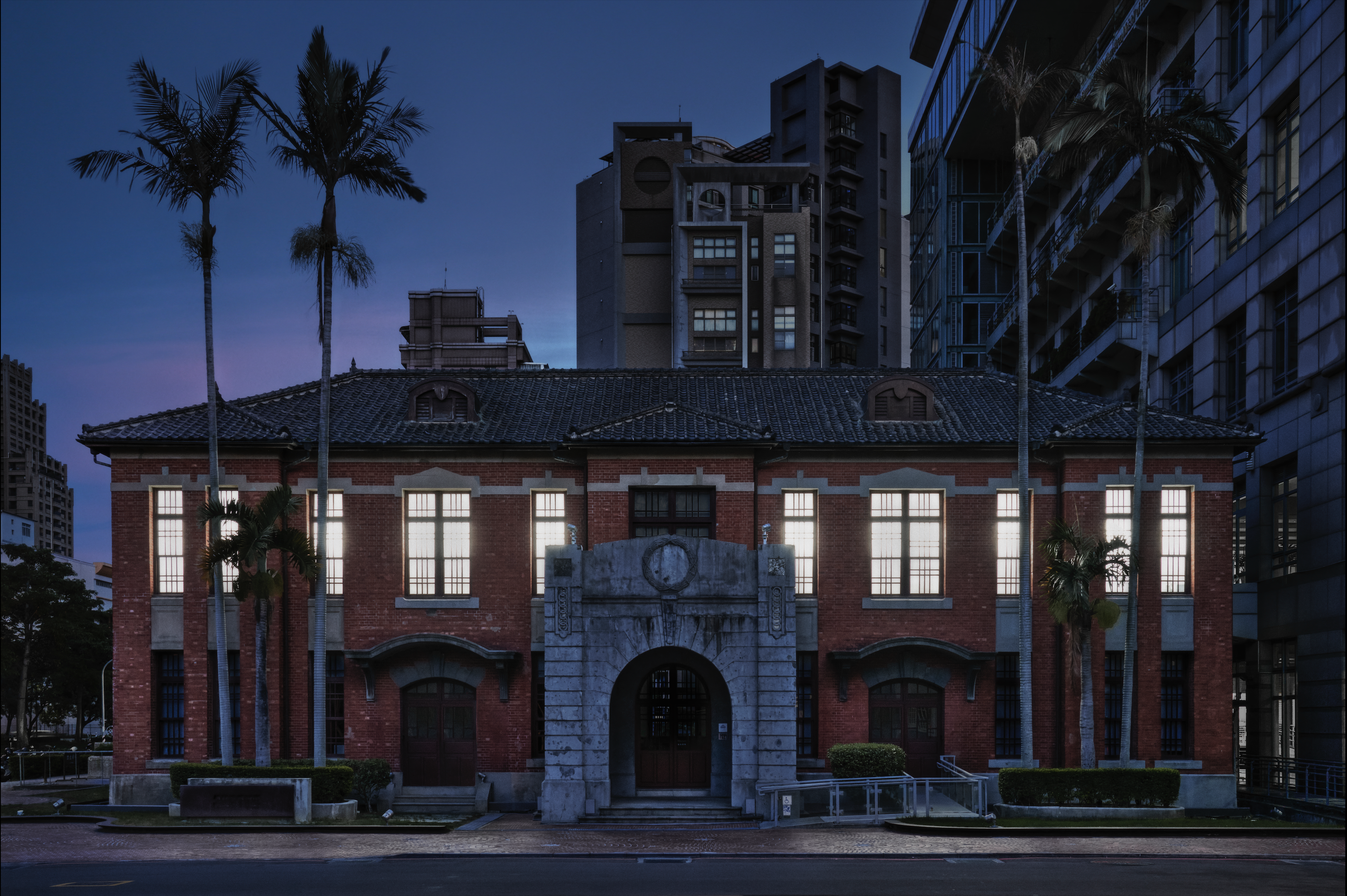
《來自竹科的月光》作品展覽紀錄照,美術館5pm打烊後燈亮起。
In the Hsinchu Science Park, after sunset, the streets were immersed in the dim and quiet, and a few vehicles occasionally passed by and broke the silence, driving off from the park.
Several neatly arranged glass windows emitted icy white light from the high ground, dwarfing the colossal building so much that even the Moon seemed almost rayless. This was indeed an icy landscape infused with technology.
“Clock in, clock out, form the mountains, and protect the country.”
In this installation, Simple Noodle Art attempts to integrate the warm tones of the old district with the cold rhythm of the Hsinchu Science Park. Usually lights off at five o’clock in the afternoon, the Hsinchu City Art Gallery shall now take shifts with the Science Park together. In this disorienting time and space, the Science Park’s night view appears in the Gallery, and perhaps, this is the most valuable, yet the least noticeable, landscape of Taiwan.
日落後的新竹科學園區,街道在昏暗與寂靜之中沉浸,偶有一、兩台車聲打破沉默,向園區外駛離。
幾面整齊排列的玻璃窗,從高處透出冷冽的白光,龐大的建築也相形失色,甚至連月光都略顯黯淡,這儼然是一幅充滿科技感的冷調風景。
「上班、下班,護國群山。」
在這件作品中,陽春麵研究舍試圖將美術館所在的舊城區的溫暖氛圍與科學園區的冷調節奏融合。平常在傍晚五點熄燈的美術館,也試著與科學園區一起輪班。科學園區夜晚的景象便在美術館中展現,仿佛時空交錯,這也許是臺灣最重要,卻也最鮮為人知的風景之一。
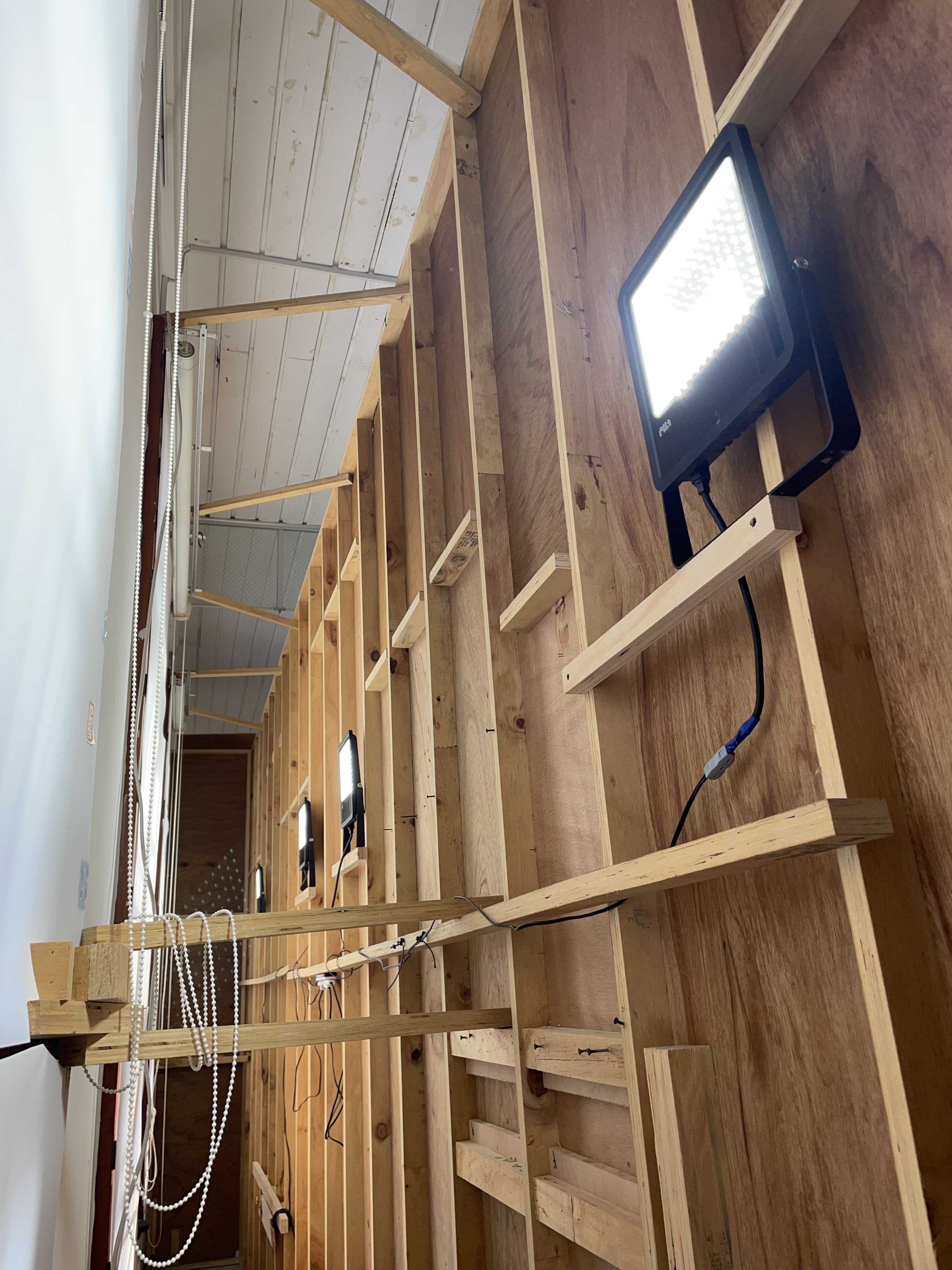
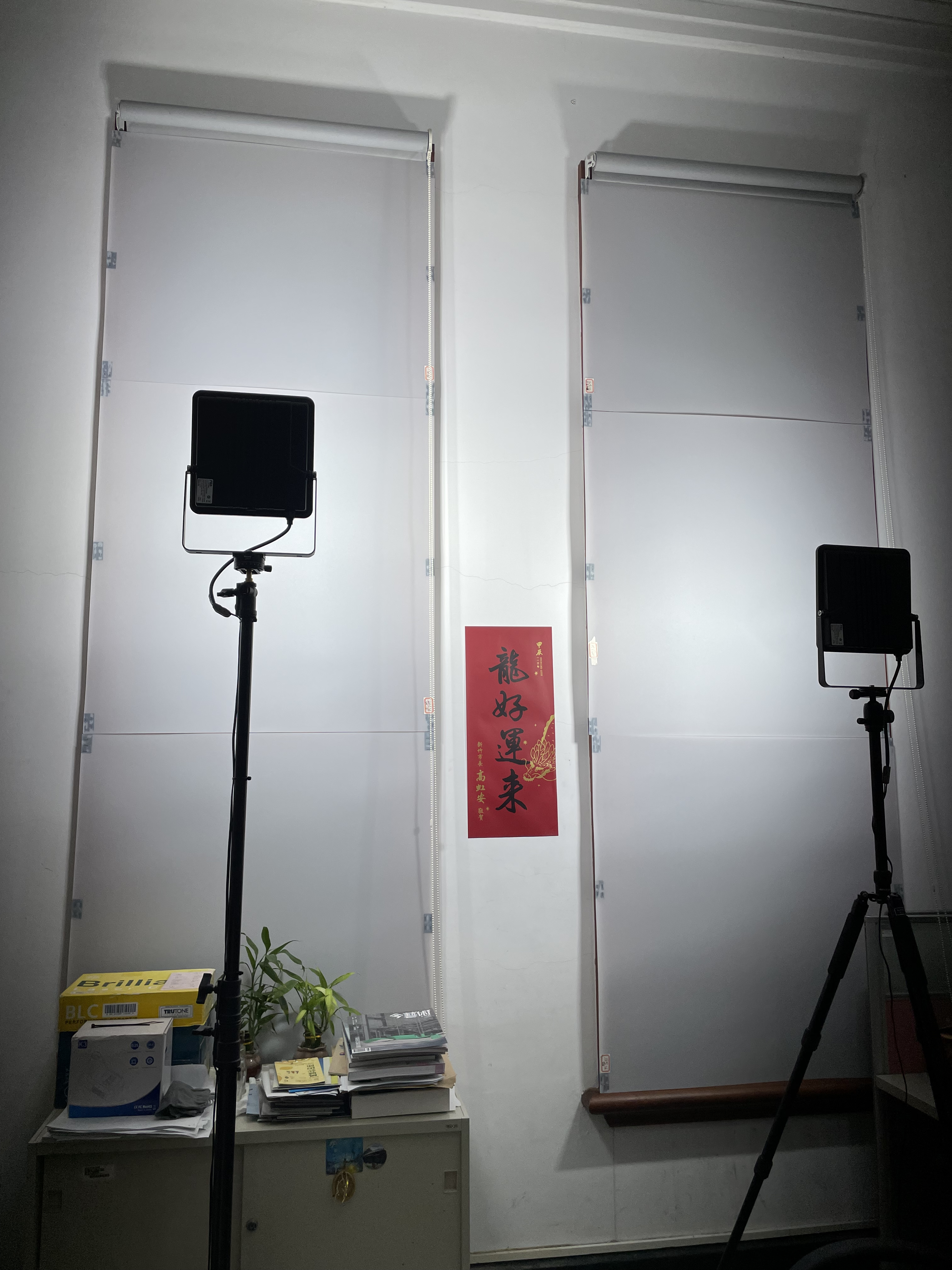
《來自竹科的月光》作品製作過程紀錄,將擴散板固定於窗戶上,並用燈照亮,燈具隱藏於展牆後方。

The Portrait
Computer-based installation
Dimension variable
2023
The Portrait
演算影像裝置
依場地而定
2023
![]()
My Self-portrait,右頻道:The crowd's portrait of me,左頻道:My Self-portrait
(圖片提供:忠泰美術館 Jut Art Museum)
Two-channel video, The Portrait, is extended from Inter net, which uses noise-like images to express descriptions about the artists via “crowdsourced labeling” and the self-writing through “Google search entries.”
The “crowdsourced labeling” and “Google search entries” in Inter net - Labeling me use the technology of text embedding to convert these textual descriptions of the artists into eigenvectors before converting the eigenvectors again into color blocks that are arranged into matrix based on a chronological order. The textual descriptions that are more similar in terms of semantics will produce blocks of more similar colors. These seemingly random noise images in fact reveal the distribution of the artists’ descriptions of “I.” As time progresses, the descriptions of “I” also become fluid and different, and the color distribution changes accordingly.
Contrasting the two different types of descriptions of “I” in this work is also an attempt to project the self into these noises that are difficult to identity but highly meaningful.
雙頻道錄像《The Portrait》為《Inter net》系列的延伸作品,兩個頻道分別為《The crowd's portrait of me》與《My Self-portrait》。皆以看似雜訊的影像,分別表現「眾包標註」以及自我書寫的「搜尋紀錄」兩種不同的對我的描述。
我把《Inter net - Labeling me》作品中的「眾包標註」以及「搜尋紀錄」,使用文本嵌入(text embedding)技術,將這些描述我的文本轉換成特徵向量,再將這些特徵向量轉換成一個個色塊,依照時間順序矩陣排列。
語意越接近的文本被轉換成的色塊,顏色會越接近。這些看似隨機的雜訊影像,實際上是對於我的描述的「分佈」(distribution),也就是說隨著時間的推移,對於我的描述隨之流動、變換,影像所呈現出來的色彩分佈也會隨之變化。
我試圖用這種視覺化的方式來對比兩種對我不同的描述的異同。也想把我自己投射在這不易辨識卻富含意義的雜訊之中。
![]()
![]()
(圖片提供:忠泰美術館 Jut Art Museum)
![]()
My Self-portrait 影像截圖
Computer-based installation
Dimension variable
2023
The Portrait
演算影像裝置
依場地而定
2023

My Self-portrait,右頻道:The crowd's portrait of me,左頻道:My Self-portrait
(圖片提供:忠泰美術館 Jut Art Museum)
Two-channel video, The Portrait, is extended from Inter net, which uses noise-like images to express descriptions about the artists via “crowdsourced labeling” and the self-writing through “Google search entries.”
The “crowdsourced labeling” and “Google search entries” in Inter net - Labeling me use the technology of text embedding to convert these textual descriptions of the artists into eigenvectors before converting the eigenvectors again into color blocks that are arranged into matrix based on a chronological order. The textual descriptions that are more similar in terms of semantics will produce blocks of more similar colors. These seemingly random noise images in fact reveal the distribution of the artists’ descriptions of “I.” As time progresses, the descriptions of “I” also become fluid and different, and the color distribution changes accordingly.
Contrasting the two different types of descriptions of “I” in this work is also an attempt to project the self into these noises that are difficult to identity but highly meaningful.
雙頻道錄像《The Portrait》為《Inter net》系列的延伸作品,兩個頻道分別為《The crowd's portrait of me》與《My Self-portrait》。皆以看似雜訊的影像,分別表現「眾包標註」以及自我書寫的「搜尋紀錄」兩種不同的對我的描述。
我把《Inter net - Labeling me》作品中的「眾包標註」以及「搜尋紀錄」,使用文本嵌入(text embedding)技術,將這些描述我的文本轉換成特徵向量,再將這些特徵向量轉換成一個個色塊,依照時間順序矩陣排列。
語意越接近的文本被轉換成的色塊,顏色會越接近。這些看似隨機的雜訊影像,實際上是對於我的描述的「分佈」(distribution),也就是說隨著時間的推移,對於我的描述隨之流動、變換,影像所呈現出來的色彩分佈也會隨之變化。
我試圖用這種視覺化的方式來對比兩種對我不同的描述的異同。也想把我自己投射在這不易辨識卻富含意義的雜訊之中。
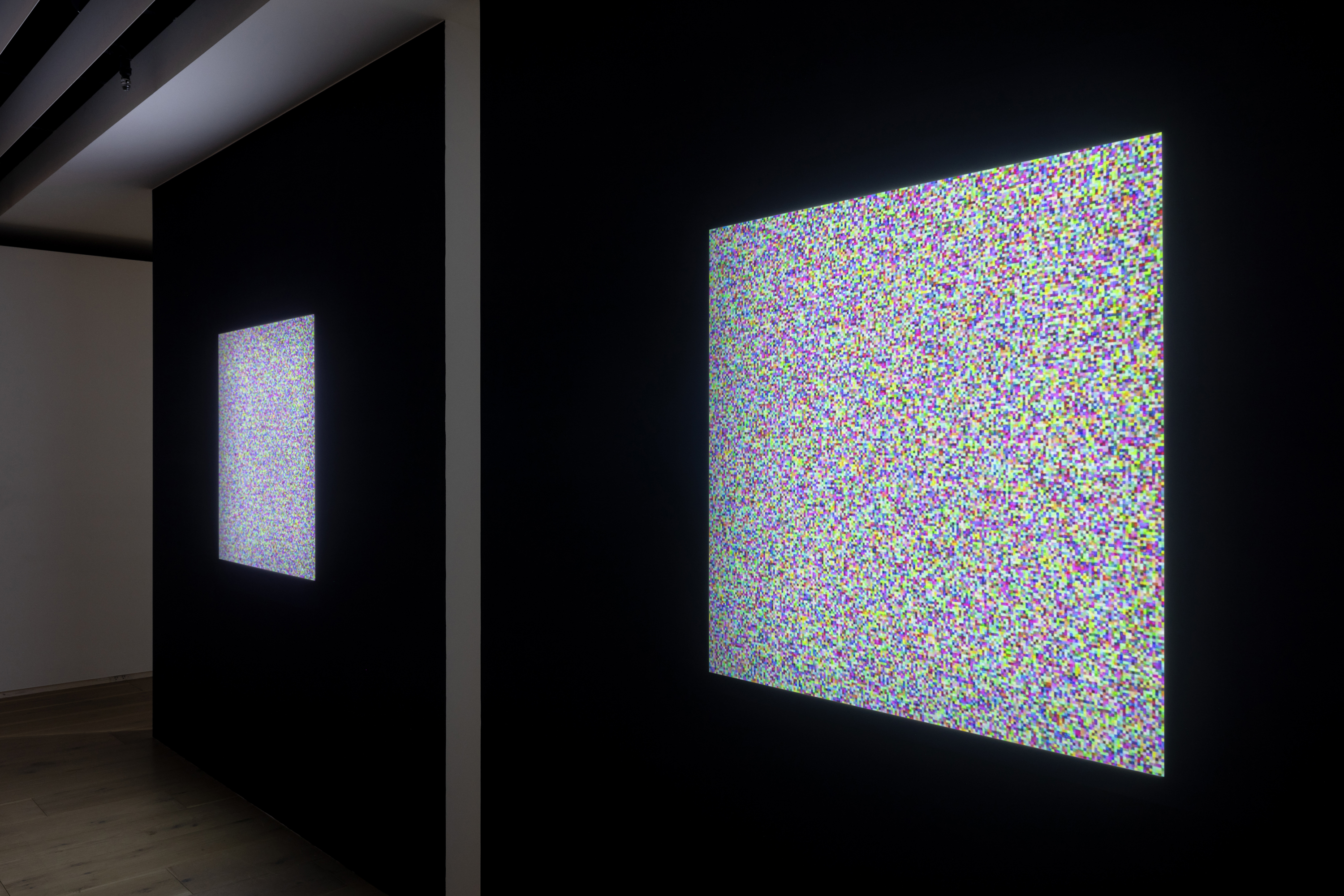

(圖片提供:忠泰美術館 Jut Art Museum)
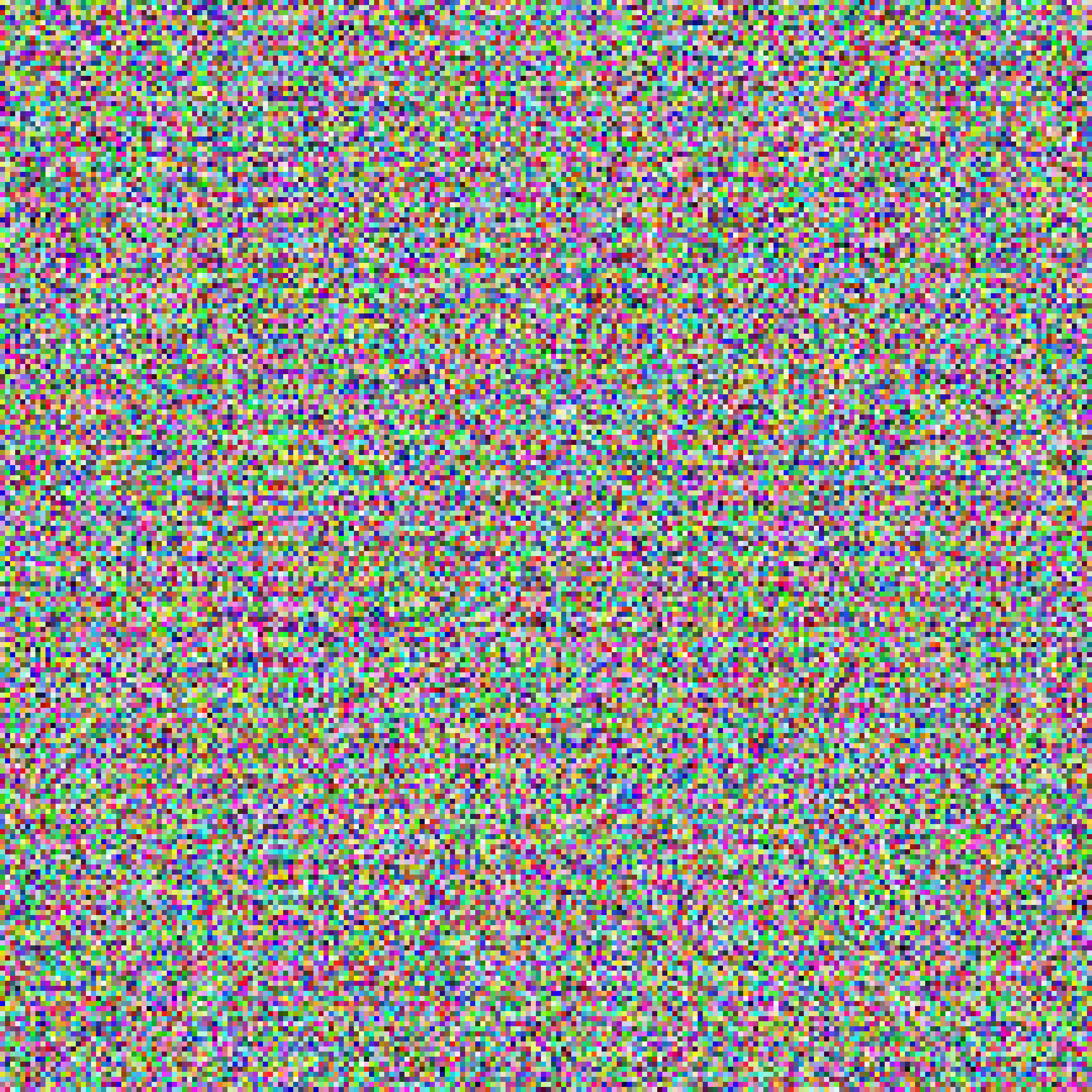
My Self-portrait 影像截圖
Exploration and Exploitation
AI Interactive Video
Dimension Variable
2024
探索與剝削
AI互動錄像
依場定而定
2024
︎Ars Electronica Festival 2024
︎林茲電子藝術節 2024
![]()
![]()
![]()
作品於林茲電子藝術節展出( 攝影:凹焦影像工作室,圖片:國美館提供 )
Does AI exacerbate social divisions when faced with the dilemma of exploring and exploiting humans? The rise of social media has changed the way and direction of information flow. As AI Recommendation algorithms deliver information in a pandering way, it seemingly increases the opportunity to access more information. However, does it also make it difficult for individuals with different standpoints to receive each other's perspectives, thus leading to an echo chamber? Are content creators in pursuit of reach, affecting the content they create?
We have developed an AI interactive video system that utilizes multiple cameras installed at the exhibition venue. The system detects the audience's facial emotions through a AI facial emotion recognition system. Based on the detected emotions, the video branches into different narrative branches.
The video content portrays an office worker returning home after work and watching a YouTube video recommended by the algorithm. The YouTube video is from an educational channel introducing the topic of "virtual companions." The audience's emotions—"positive," "neutral," or "negative"—correspond to three different perspectives in the introduction: "tech optimism," "scientific explanation," and "pessimistic warnings," respectively.
當AI面臨探索和剝削人類的兩難境地下,是否加劇了社會分裂? 社交媒體的崛起改變了信息流動的方式和方向。隨著 AI 推薦算法以迎合的方式傳遞信息,它似乎增加了接觸更多信息的機會。然而,這是否也使得持不同立場的個體難以接收彼此的觀點,從而導致同溫層的形成?內容創作者是否因追求傳播範圍而影響了他們創作的內容?
我們開發了一個AI互動錄像系統,在展場架設多台攝影機,以AI人臉情緒辨識系統偵測觀眾在觀看時臉部的情緒,跟AI推薦系統演算法一樣,以一種「投其所好」的邏輯,選擇播放的觀點。
影片內容為一名上班族下班回到家,點選推薦演算法推薦的Youtube影片觀看,Youtube影片為一個知識型Youtube頻道以「虛擬伴侶」為題的介紹影片,觀眾的「正面」、「中性」、「負面」分別對應到對於到「科技樂觀主義」、「科普介紹」、「悲觀示警」等三種不同介紹觀點。
![]()
The YouTube video collaborated with PanSci to record three different introductory perspectives: positive, neutral, and negative, presented with varying color temperatures and tones. By detecting the facial emotions of viewers while watching, the video adjusts its branching based on their emotional responses.
Youtube影片與泛科學合作,錄製了正面、中性、負面三種不同的介紹觀點, 以不同的色溫與色調呈現。透過偵測現場觀眾觀看時的人臉情緒,並依據此情緒改變影片的分支。
![]()
![]()
![]()
作品於林茲電子藝術節展出(攝影:凹焦影像工作室,圖片:國美館提供)
A message board was set up at the exhibition, allowing viewers to respond to the questions posed in the video and express their viewpoints after watching.
展場設置了留言板,觀眾看完影片後可以回應影片中的提問並表達觀點。
![]() Video branching diagram
Video branching diagram
影片分支示意
︎This project uses the following open-source libraries:
onnxruntime - Licensed under the MIT License.
fastapi - Licensed under the MIT License.
screeninfo - Licensed under the MIT License.
hsemotion-onnx - Licensed under the Apache-2.0 License.
onnx - Licensed under the Apache-2.0 License.
opencv-python - Licensed under the Apache-2.0 License.
pymongo - Licensed under the Apache-2.0 License.
numpy - Licensed under the BSD-3-Clause License.
uvicorn - Licensed under the BSD-3-Clause License.
︎ Github: https://github.com/Shanboy5566/hsemotion-onnx
This work was co-produced by National Taiwan Museum of Fine Arts & Ars Electronica in 2024, with support from the Ministry of Culture (Taiwan), R.O.C., under the Technology Art Venues Innovation Project and the Taiwan Content Plan.
本作品由文化部「藝文場館科藝創新計畫」和「匯聚臺流文化黑潮計畫」支持,並由國立臺灣美術館與林茲電子藝術節共同製作。
導演:陽春麵研究舍
執行導演:丁啟文
場記:陳姿尹
編劇:丁啟文
編劇助理:謝富丞 、陽春麵研究舍
製作人:陽春麵研究舍
共同製片人:林茲電子藝術節、國立台灣美術館
行政製片人:邱誌勇、賴駿杰、Laura Welzenbach、Emiko Ogawa、Lisa Shchegolkova
協同製片人:泛科學
AI互動系統開發:陳宣伯 、莊向峰
演員:洪德高 、鄭國威
攝影:廖鏡文
燈光:梁敦學
收音:顏英琪
剪輯:陳姿尹、莊向峰
調光:莊向峰
視覺特效:黃詣翔、陳仲威
聲音指導:陳奎瀚
字幕翻譯:戴思博
平面設計:周芳伃
特別感謝:沈伯丞
AI Interactive Video
Dimension Variable
2024
探索與剝削
AI互動錄像
依場定而定
2024
︎Ars Electronica Festival 2024
︎林茲電子藝術節 2024



作品於林茲電子藝術節展出( 攝影:凹焦影像工作室,圖片:國美館提供 )
Does AI exacerbate social divisions when faced with the dilemma of exploring and exploiting humans? The rise of social media has changed the way and direction of information flow. As AI Recommendation algorithms deliver information in a pandering way, it seemingly increases the opportunity to access more information. However, does it also make it difficult for individuals with different standpoints to receive each other's perspectives, thus leading to an echo chamber? Are content creators in pursuit of reach, affecting the content they create?
We have developed an AI interactive video system that utilizes multiple cameras installed at the exhibition venue. The system detects the audience's facial emotions through a AI facial emotion recognition system. Based on the detected emotions, the video branches into different narrative branches.
The video content portrays an office worker returning home after work and watching a YouTube video recommended by the algorithm. The YouTube video is from an educational channel introducing the topic of "virtual companions." The audience's emotions—"positive," "neutral," or "negative"—correspond to three different perspectives in the introduction: "tech optimism," "scientific explanation," and "pessimistic warnings," respectively.
當AI面臨探索和剝削人類的兩難境地下,是否加劇了社會分裂? 社交媒體的崛起改變了信息流動的方式和方向。隨著 AI 推薦算法以迎合的方式傳遞信息,它似乎增加了接觸更多信息的機會。然而,這是否也使得持不同立場的個體難以接收彼此的觀點,從而導致同溫層的形成?內容創作者是否因追求傳播範圍而影響了他們創作的內容?
我們開發了一個AI互動錄像系統,在展場架設多台攝影機,以AI人臉情緒辨識系統偵測觀眾在觀看時臉部的情緒,跟AI推薦系統演算法一樣,以一種「投其所好」的邏輯,選擇播放的觀點。
影片內容為一名上班族下班回到家,點選推薦演算法推薦的Youtube影片觀看,Youtube影片為一個知識型Youtube頻道以「虛擬伴侶」為題的介紹影片,觀眾的「正面」、「中性」、「負面」分別對應到對於到「科技樂觀主義」、「科普介紹」、「悲觀示警」等三種不同介紹觀點。

The YouTube video collaborated with PanSci to record three different introductory perspectives: positive, neutral, and negative, presented with varying color temperatures and tones. By detecting the facial emotions of viewers while watching, the video adjusts its branching based on their emotional responses.
Youtube影片與泛科學合作,錄製了正面、中性、負面三種不同的介紹觀點, 以不同的色溫與色調呈現。透過偵測現場觀眾觀看時的人臉情緒,並依據此情緒改變影片的分支。



作品於林茲電子藝術節展出(攝影:凹焦影像工作室,圖片:國美館提供)
A message board was set up at the exhibition, allowing viewers to respond to the questions posed in the video and express their viewpoints after watching.
展場設置了留言板,觀眾看完影片後可以回應影片中的提問並表達觀點。

影片分支示意
︎This project uses the following open-source libraries:
onnxruntime - Licensed under the MIT License.
fastapi - Licensed under the MIT License.
screeninfo - Licensed under the MIT License.
hsemotion-onnx - Licensed under the Apache-2.0 License.
onnx - Licensed under the Apache-2.0 License.
opencv-python - Licensed under the Apache-2.0 License.
pymongo - Licensed under the Apache-2.0 License.
numpy - Licensed under the BSD-3-Clause License.
uvicorn - Licensed under the BSD-3-Clause License.
︎ Github: https://github.com/Shanboy5566/hsemotion-onnx
This work was co-produced by National Taiwan Museum of Fine Arts & Ars Electronica in 2024, with support from the Ministry of Culture (Taiwan), R.O.C., under the Technology Art Venues Innovation Project and the Taiwan Content Plan.
本作品由文化部「藝文場館科藝創新計畫」和「匯聚臺流文化黑潮計畫」支持,並由國立臺灣美術館與林茲電子藝術節共同製作。
導演:陽春麵研究舍
執行導演:丁啟文
場記:陳姿尹
編劇:丁啟文
編劇助理:謝富丞 、陽春麵研究舍
製作人:陽春麵研究舍
共同製片人:林茲電子藝術節、國立台灣美術館
行政製片人:邱誌勇、賴駿杰、Laura Welzenbach、Emiko Ogawa、Lisa Shchegolkova
協同製片人:泛科學
AI互動系統開發:陳宣伯 、莊向峰
演員:洪德高 、鄭國威
攝影:廖鏡文
燈光:梁敦學
收音:顏英琪
剪輯:陳姿尹、莊向峰
調光:莊向峰
視覺特效:黃詣翔、陳仲威
聲音指導:陳奎瀚
字幕翻譯:戴思博
平面設計:周芳伃
特別感謝:沈伯丞